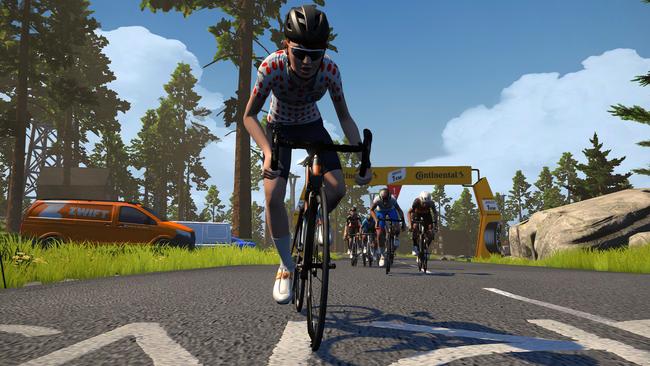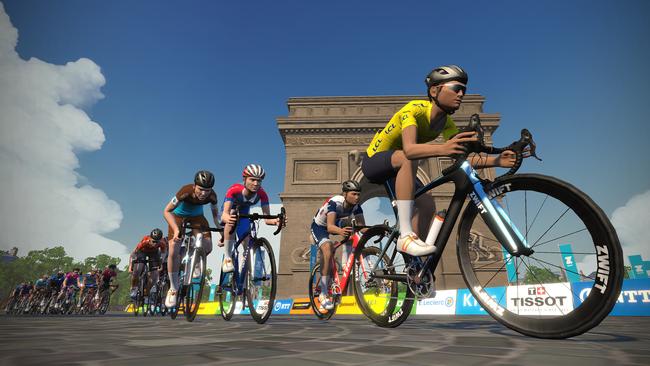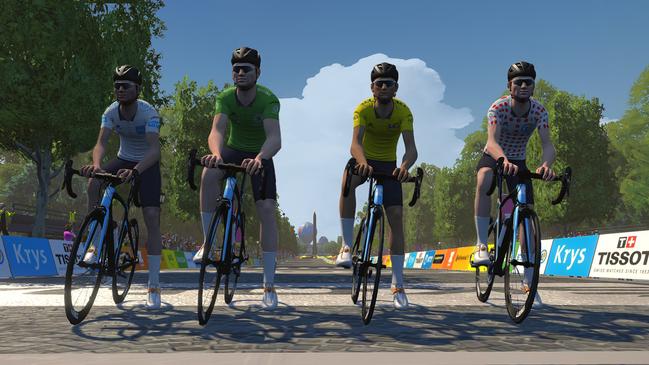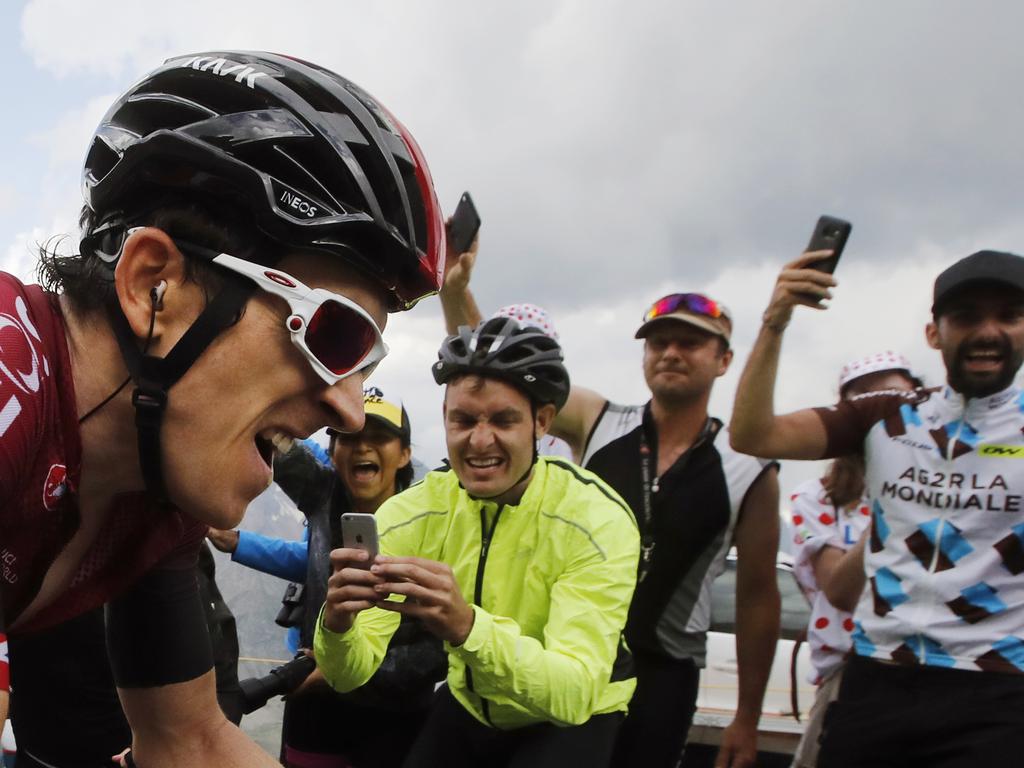Tour de France morphs into virtual space
The world’s iconic cycling race, Tour de France, will take place with real riders slogging it out in virtual depictions of Paris and France’s mountainous terrain.

The coming virtualised Tour de France brings together multiplayer gaming and real life athleticism.
You can always give a team player a PlayStation or Xbox console and let them compete in a games depiction of their craft such as the ePremier league. But it’s a game.
Professional esports motor racing gets closer to invoking the real world skill set. Some have successfully transitioned from virtual to real world car racing. The realism of the graphics used in virtualised Formula One, Le Mans 24 and Grand Prix events during coronavirus lockdown made them worthy events for sports channels to televise.
The virtualisation of cycling takes this to a new level because you can transfer the real athleticism of cycling – the speed and endurance of professional cyclists on trainers at home – into the virtual world.
The event will be held on gaming-style recreations of tracks in Paris and France’s mountainous terrain used for the official event.
Twenty-three men’s and 17 women’s professional teams comprising participants in the delayed race will take part, including some iconic Australian riders. Rohan Dennis, Cameron Wurf, Jessica Pratt, Michael Matthews, Chris Hamilton, Michael Storer and Nathan Haas are confirmed so far.
They may be pedalling at home, but they’ll appear on video feeds as cycling avatars racing in a virtual race, and they will progress according to their athletic performance.
Each cyclist will have their own feed showing the view in front of them along roads and tracks. It’s what you’d expect in multiplayer gaming.
The official Tour de France is now set for late August-September.
Christian Prudhomme, director of the Tour de France, said he could not imagine July without cycling.
“Thanks to the virtual Tour de France, which will be widely broadcast on TV, the champions and their fans will fill in the void left by the Tour de France, which will reunite with the public in Nice on 29 August,” he said. “The Tour Virtuel puts technology to work for passion and the cause of cycling for everyone.“

The builder of the virtual cycling environments, sport multiplayer gaming company Zwift, said the same broadcasters covering the realworld race could cover the virtualised one. Zwift said it had created camera feeds so that the race can be shown in more than 130 countries.
The technicalities of replicating French environments for Tour de France and holding races shouldn’t be a problem for Zwift which hosts a few hundred races every day for regular riders.
SBS has confirmed that in Australia it will show the initial races on SBS on Demand and broadcast the finals on SBS VICELAND on Saturday July 18 and Sunday July 19.
Zwift co-founder and CEO Eric Min told The Australian that the idea of the virtual Tour de France was hatched in May.
Organiser of the Tour de France, The Amaury Sport Organisation (ASO), said it was enthusiastic about the event. “Our joint project with cycling teams, Zwift, charities and broadcasters is all about leveraging the newest e-sport technologies to put the spotlight on the champions who were supposed to ride the Tour de France in July, as well as bringing bicycles to people who do not have any.”
As with real world cycling, pedalling uphill in a virtual world is harder and downhill is easier. The game can replicate the feeling of bumps travelling over rough virtual roads and timber bridges.
Mr Min said it made sense for the ASO to host a virtualised Tour de France because so many official riders had used the Zwift platform during lockdowns. He said the virtualised event was a no-brainer.
“You have professional riders who aren‘t racing, they’re locked down. You have event promoters who can’t hold an event because of the pandemic. Your fans are hungry for content. It just made so much sense to the ASO.”

He said virtual cyclists would display numbers so they could be recognised.
Other confirmed names include Chris Froome, Geraint Thomas, Egan Bernal and Greg Van Avermaet for the men’s race, and Marianne Vos and Anna Van der Bregen for the women’s event. Zwift has named five charities to benefit from it.
The Virtual Tour de France will be shorter, just three weekends compared to the official race held over 23 days. Some facets will be the same, such as the yellow, green, polka-dot and white jerseys held by race leaders.
The L‘Étape du Tour, where amateur cyclists race the same route as professionals, will be virtualised as three virtual courses available on the three weekends of the race and after the event.
Formed in 2014, Zwift already operates six cycling worlds for its member cyclists, each comprising a network of cycling tracks and experiences. They include London, New York, Innsbruck, Richmond Virginia and Yorkshire, and Zwift’s own fantasy world of “Watopia”, where cycling tracks run over streaming lava and around a volcanic island, along transparent underwater tunnels and through forests and jungles.
Users pick and follow designated routes around these worlds but they can opt to turn left or right at intersections and do U-turns and explore environments their own way. Zwift is testing a steering capability that will let riders use their handlebars. It’s available at one virtual test location.

Zwift offers other experiences to advanced cyclists such as the Alpe du Zwift, its reproduction of the 21 hairpin bends of Alpe d’Huez – part of the Tour de France.
Every day, the system provides thousands of cyclists online with an individualised video feed of the view in front of them, complete with other cyclists and runners. It’s classic multiplayer gaming technology.
Mr Min said virtual Australian routes were under consideration for the future. “We have a long list of worlds that we want to create,” he said. “If we did something like Sydney, you’d go from Sydney to Melbourne”.

Zwift is not the only company offering virtual cycling experiences. Competitors include Fulgaz, Bkool, BigRingVR, Rouvy and Sufferfest.
Zwift reportedly has grown from 200,000 users to one million registered users in two years.
Mr Min said lockdowns had seen further growth. In March and early April during lockdowns, Zwift gained half of the customers it had gained in the previous 12 months. “That is a huge spike,” he said.
Zwift also offers virtualised running, and rowing is being rolled out.



To join the conversation, please log in. Don't have an account? Register
Join the conversation, you are commenting as Logout